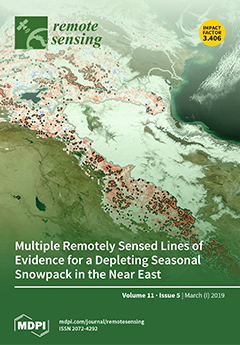Leaf angle is a critical structural parameter for retrieving canopy leaf area index (LAI) using the PROSAIL model. However, the traditional method using default leaf angle distribution in the PROSAIL model does not capture the phenological dynamics of canopy growth. This study presents
[...] Read more.
Leaf angle is a critical structural parameter for retrieving canopy leaf area index (LAI) using the PROSAIL model. However, the traditional method using default leaf angle distribution in the PROSAIL model does not capture the phenological dynamics of canopy growth. This study presents a LAI retrieval method for corn canopies using PROSAIL model with leaf angle distribution functions referred from terrestrial laser scanning points at four phenological stages during the growing season. Specifically, four inferred maximum-probability leaf angles were used in the Campbell ellipsoid leaf angle distribution function of PROSAIL. A Lookup table (LUT) is generated by running the PROSAIL model with inferred leaf angles, and the cost function is minimized to retrieve LAI. The results show that the leaf angle distribution functions are different for the corn plants at different phenological growing stages, and the incorporation of derived specific corn leaf angle distribution functions distribute the improvement of LAI retrieval using the PROSAIL model. This validation is done using in-situ LAI measurements and MODIS LAI in Baoding City, Hebei Province, China, and compared with the LAI retrieved using default leaf angle distribution function at the same time. The root-mean-square error (RMSE) between the retrieved LAI on 4 September 2014, using the modified PROSAIL model and the in-situ measured LAI was 0.31 m
2/m
2, with a strong and significant correlation (R
2 = 0.82, residual range = 0 to 0.6 m
2/m
2, p < 0.001). Comparatively, the accuracy of LAI retrieved results using default leaf angle distribution is lower, the RMSE of which is 0.56 with R
2 = 0.76 and residual range = 0 to 1.0 m
2/m
2, p < 0.001. This validation reveals that the introduction of inferred leaf angle distributions from TLS data points can improve the LAI retrieval accuracy using the PROSAIL model. Moreover, the comparations of LAI retrieval results on 10 July, 26 July, 19 August and 4 September with default and inferred corn leaf angle distribution functions are all compared with MODIS LAI products in the whole study area. This validation reveals that improvement exists in a wide spatial range and temporal range. All the comparisons demonstrate the potential of the modified PROSAIL model for retrieving corn canopy LAI from Landsat imagery by inferring leaf orientation from terrestrial laser scanning data.
Full article





